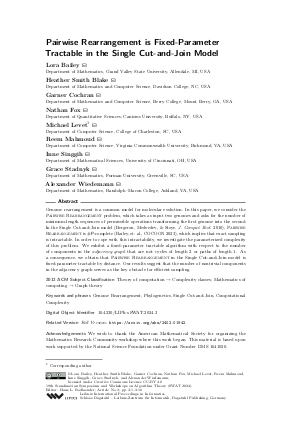LIPIcs.SWAT.2024.3.pdf
- Filesize: 0.72 MB
- 16 pages

 Creative Commons Attribution 4.0 International license
Creative Commons Attribution 4.0 International license

Genome rearrangement is a common model for molecular evolution. In this paper, we consider the Pairwise Rearrangement problem, which takes as input two genomes and asks for the number of minimum-length sequences of permissible operations transforming the first genome into the second. In the Single Cut-and-Join model (Bergeron, Medvedev, & Stoye, J. Comput. Biol. 2010), Pairwise Rearrangement is #P-complete (Bailey, et. al., COCOON 2023), which implies that exact sampling is intractable. In order to cope with this intractability, we investigate the parameterized complexity of this problem. We exhibit a fixed-parameter tractable algorithm with respect to the number of components in the adjacency graph that are not cycles of length 2 or paths of length 1. As a consequence, we obtain that Pairwise Rearrangement in the Single Cut-and-Join model is fixed-parameter tractable by distance. Our results suggest that the number of nontrivial components in the adjacency graph serves as the key obstacle for efficient sampling.

Feedback for Dagstuhl Publishing